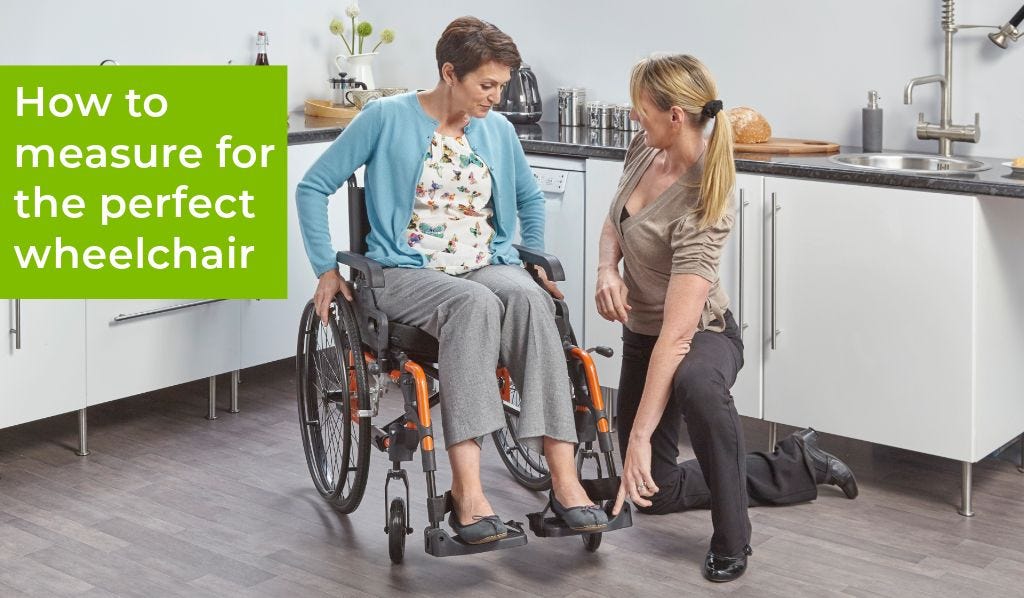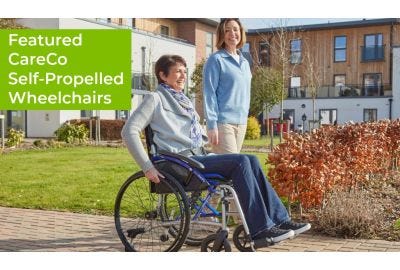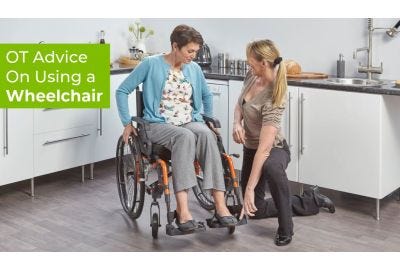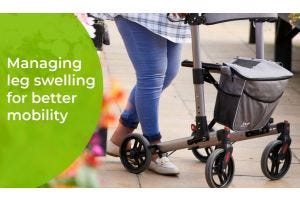Guide to Finding the Perfect Fit Wheelchair
This guide covers:
- How to measure seat size
- Importance of seat height
- Backrest and armrest positions
- Difference between self-propelled and transit chairs
- Why try before you buy is a good idea
Of all the mobility aids we sell, the wheelchair is possibly the most important to get right size-wise. A poorly fitting wheelchair can quickly become unbearably uncomfortable and prolonged use can cause aches, pains and sores. We recommend that if at all possible you visit a CareCo showroom to try out a range of wheelchairs before ordering, however, if you have no option but to order online, then this guide will help you get the best size to meet your needs.
Why wheelchair size matters
- Comfort: Because you spend so much time in a wheelchair, comfort is the most important factor. If the seat is too narrow or too deep, you’ll soon start to notice aches and pains in the lower back and legs.
- Pressure distribution: Pressure ulcers can form when the skin cannot breathe and circulation is reduced, so a wheelchair needs to provide all0round comfort. A good cushion can go a long way to resolve issues.
- Access and control: The wheelchair also needs to fit your home, so be sure to check that the maximum width is smaller than your doorways. Also, the sizing of the chair can impact how easy it is to self-propel. You want your arms to rest in an optimum position on the wheel rims, and the seat should be of a height that allows you to easily sit down and stand up.
- Posture and support: Wrong sizing can also affect your posture, which can lead to long-term issues.
Key Measurements for Wheelchair Selection
The most important measurement to get right is the seat: it’s width, depth and height are key, and backrest and armrests also important.
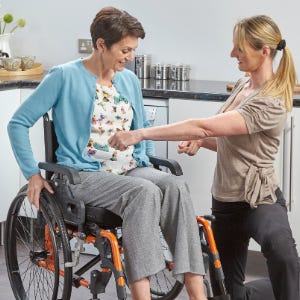 Seat Width: Easy Hip Measurement
Seat Width: Easy Hip Measurement
While sitting in an armchair measure the distance between your hips or thighs - it helps to have somebody assist with this. Add one or two inches to this measurement, and this is your ideal seat width.
You want a little room each side to prevent rubbing, but not so much that you feel you’re rattling around on the chair. The extra space also allows for when you are wearing a large coat or allows more cushioning in colder months.
If your wheelchair seat is too wide it will also be more difficult to self-propel, and a wider seat will also mean a wider wheelchair overall, which means you may struggle more to get around indoors.
It's also easier to use a self-propelled wheelchair if it fits well. Adult wheelchairs usually come in sizes from 16 through to 22 inches wide, with 18 and 20 inches being the most popular; the I-GO Airrex LT Self Propelled Wheelchair can be bought with a 16, 18 or inch seat.
Seat Depth: Thigh Comfort
While sitting with your lower back and hips firmly against the back of the chair, measure the distance from the chair back to the back of your knees. Take 1-2 inches off this size for your ideal seat depth.
Our wheelchairs generally range from 15 3/4in to 17 inch, so there is not a huge difference in options, but unlike width, it can be far more noticeable if the wheelchair depth is too much or too little. Your height, thigh length, posture and activity levels will all affect ideal seat depth.
Smaller transit chairs, such as the Xpedition Transport Chair, have a 40cm deep seat, with larger ones such as the CareCo Ergo Pro Transit with a 42cm seat, and the CareCo Travel Air Compact Wheelchair with 43cm.
Seat Height: Foot on the Floor or Footplate?
Seat height can be tricky to get right as you need to consider whether you will spend more time with your feet on the floor or on the footrests.
For those who wish to self-propel with their feet, a lower seat is required, but for transit chairs then comfort with feet on a footrest is most important. However, getting on and off the wheelchair may require assistance of the seat is too high.
When a seat is too low it can lead to too much pressure on the back of the thighs, and this can reduce circulation.
It’s important to consider the type and thickness of cushion when measuring for seat height - if you prefer a 3 inch thick cushion, then deduct this from the measured height.
To measure the correct wheelchair seat height, measure the sole of your feet to the back of your thigh when seated with feet flat on the floor and your knees are bent about 90 degrees.
If you plan to use a cushion, you can either measure when seated on the cushion, or take the height of the cushion off the measured height.
As you can see, it is possible to take useful measurements yourself at home, but trying out different wheelchairs in a showroom will always be a more reliable way to pick a well-fitting wheelchair.
Get professional advice
If you are in any doubt, please call our sales experts on 0333 015 5000, or visit one of our showrooms. We now have a showroom within a 40 minutes drive for 70% of the UK, so if you can visit a CareCo mobility shop we can give your personal advice and you can test out our whole range of wheelchairs and our showroom staff will be able happy to advise which models best suit you.
FAQs
- Q: Why is the right wheelchair size important?
- It ensures comfort, prevents sores, aids movement, and supports good posture
- Q: How do I measure for wheelchair seat width?
- Sit and measure across your hips or thighs, then add 1-2 inches.
- Q: What's the best way to find my wheelchair seat depth?
- Measure from the back of your hips to behind your knees, then subtract 1-2 inches.
- Q: How do I determine the correct wheelchair seat height?
- Consider if you'll use your feet for propulsion or primarily use footrests. Measure from the sole of your foot to the back of your thigh while seated. Factor in cushion thickness.
- Q: What if I'm unsure about the right size?
- Visit a showroom to try different wheelchairs or contact sales experts for advice.
- Q: Should I consider the wheelchair cushion when measuring?
- Yes, the cushion's thickness affects the final seat height.
- Q: Is seat height different for self-propelled vs. transit wheelchairs?
- Yes, self-propelled chairs need a height that allows foot propulsion, while transit chairs focus on footrest comfort.


 Price Match Promise
Price Match Promise
 Next day delivery, 7 days a week
Next day delivery, 7 days a week
 Nationwide Showrooms
Nationwide Showrooms
 Rated Excellent
Rated Excellent
